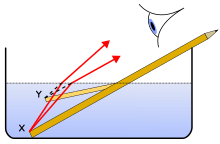I am posting the relevant portions about the mid-level vedanta philosophies from Wikipedia which you may find useful. The different schools are Nimbarka's Dvaita-Advaita, Ramanuja's Vishishta-Advaita, Vallabha's Shuddha-Advaita and Chaitanya's Acintya Bhedabheda Vedanta.
The characteristic position of all the different Bhedābheda Vedānta schools is that the individual self (
jīvātman) is both different and not different from the ultimate reality known as Brahman. Each thinker within the Bhedābheda Vedānta tradition has their own particular understanding of the precise meanings of the philosophical terms "difference" and "non-difference". Bhedābheda Vedāntic ideas can be traced to some of the very oldest Vedāntic texts, including quite possibly Bādarāyaṇa's
Brahma Sūtra (c. 4th century CE).
Bhedābheda predates the positions of two other major schools of Vedānta. The
Advaita (Non-dual) Vedānta that claims that the individual self is completely identical to Brahman, and the
Dvaita (Dualist) Vedānta (13th century) that teaches complete difference between the individual self and Brahman.
Nimbarka (7th Century ?): According to Nimbarka, there are three categories of existence, namely
Isvara (God, Divine Being);
cit (
jiva, the individual soul); and
acit (lifeless matter). Cit and acit are different from Isvara, in the sense that they have attributes (Guna) and capacities (Swabhaava), which are different from those of
Isvara. At the same time,
cit and
acit are not different from
Isvara, because they cannot exist independently of Him. Isvara is independent and exists by Himself, while
cit and
acit exist in dependence upon Him. Difference means a kind of existence which is separate but dependent, (para-tantra-satta-bhava); while non-difference means impossibility of separate existence (svatantra-satta-bhava).
Vallabha: The school of in-essence
monism or purified non-dualism of Vallabha sees equality in "essence" of the individual self with God. There is no real difference between the two (like the analogy of sparks to fire). However, unlike
Shankara's
Advaita, Vallabha does not deny God as the whole and the individual as the part. The individual soul is not the Supreme (
Satcitananda) clouded by the force of
avidya, but is itself
Brahman, with one attribute (ananda) rendered imperceptible. The soul is both a doer and enjoyer.
Ramanuja:
VishishtAdvaita (literally "
Advaita with uniqueness; qualifications") is a non-dualistic school of Vedanta philosophy. It is
non-dualism of the qualified whole, in which Brahman alone exists, but is characterized by multiplicity. It can be described as qualified monism or qualified non-dualism or attributive
monism. It is a school of Vedanta philosophy which believes in all diversity subsuming to an underlying unity.
Asesha Chit-Achit Prakaaram Brahmaikameva Tatvam: Living and non-living are the various modes of Brahman with no remainder(i.e., there is no exception)
Chaitanya (Hare-Krishnas): The philosophy of Achintya-bheda-abheda includes elements of both viewpoints (Dvaita and Advaita). The living soul is intrinsically linked with the Supreme Lord, and yet at the same time is not the same as God - the exact nature of this relationship being inconceivable to the human mind. The Soul is considered to be part and parcel of the Supreme Lord. Same in quality but not in quantity. God having all opulence in fullness, the spirit soul however, having only a partial expression of His divine opulence. God in this context is compared to a fire and the souls as sparks coming off of the flame.
The best explanation of these philosophies is in Surendranath Dasgupta's History of Indian Philosophy (Part 1 for a short description and Part 3 for a full description). The book is avalaible at Archives.org. Part 1 will be enough for your purpose. I will go through that and post what I find important.

